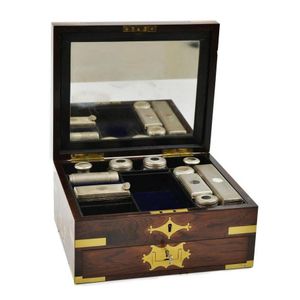Victorian Games Box with Multiple Games and Provenance
You must be a subscriber, and be logged in to view price and dealer details.
Subscribe Now to view actual auction price for this item
When you subscribe, you have the option of setting the currency in which to display prices to $Au, $US, $NZ or Stg.
- Victorian Period - The Victorian period of furniture and decorative arts design covers the reign of Queen Victoria from 1837 to 1901. There was not one dominant style of furniture in the Victorian period. Designers used and modified many historical styles such as Gothic, Tudor, Elizabethan, English Rococo, Neoclassical and others, although use of some styles, such as English Rococo and Gothic tended to dominate the furniture manufacture of the period.
The Victorian period was preceded by the Regency and William IV periods, and followed by the Edwardian period, named for Edward VII (1841 ? 1910) who was King of the United Kingdom and the British Dominions and Emperor of India for the brief period from 1901 until his death in 1910. - Ebony - Ebony is a close grained timber, black in colour. It has a fine texture which can be polished to a high gloss, making it suitable for venereering, inlay and stringing and its use as solid timber is resticted to small decorative items and ornamental decoration, such as chess pieces and musical instrument parts. The term "ebonised" means "faux ebony", timber that has been darkened during the polishing process to resemble ebony.
- Mahogany - Mahogany is a dense, close grained red-coloured timber from the West Indies and Central America. It was first imported into Europe in the the early 18th century and its use continued through the 19th century. It was popular for furniture making because of its strength, the wide boards available, the distinctive grain on some boards, termed flame mahogany and the rich warm colour of the timber when it was polished.. The "flame" was produced where a limb grew out from the trunk of the tree, and this timber was usually sliced into veneers for feature panels on doors, backs and cornices.
Some terms used to describe mahogany relate to the country from which it originally came, such as "Cuban" mahogany, "Honduras" mahogany etc. However unless the wood has been tested the names assigned are more a selling feature, rather than a true indication of the timber's origin.
This item has been included into following indexes:
Visually similar items

Extensive Christoffle cutlery canteen, c.1910, includes flatware, serving utensils and condiments

A Victorian rosewood veneered travelling vanity box, the vanity box with cut brass detail, the fitted blue velvet and leather interior containing five silver plate canisters, two silver plate bottles and two rectangular boxes, above a single drawer, 14.5 x

A walnut fold out writing slope, mid 19th century, inlaid with ivory, pearl shell, ebony and amboyna, labelled 'J.EWINS, 49 STURT ST. BALLARAT, 18 cm high, 36 cm wide, 28 cm deep

An oak cased canteen of sterling silver cutlery, consisting of twelve table forks, dessert forks, dessert spoons, tablespoons and teaspoons, six egg spoons, two sauce ladles, one large soup ladle and a pair of knife rests. Old English pattern, various date
